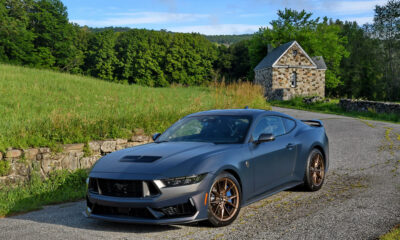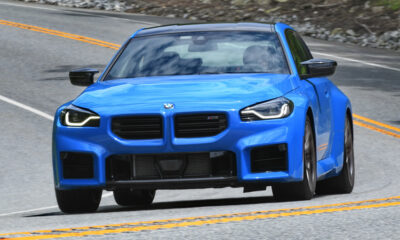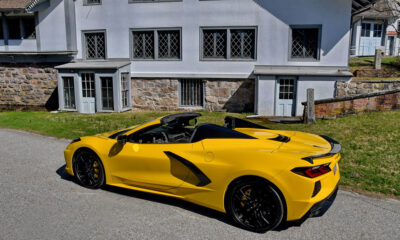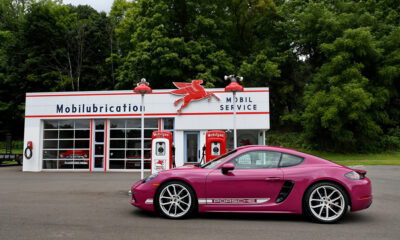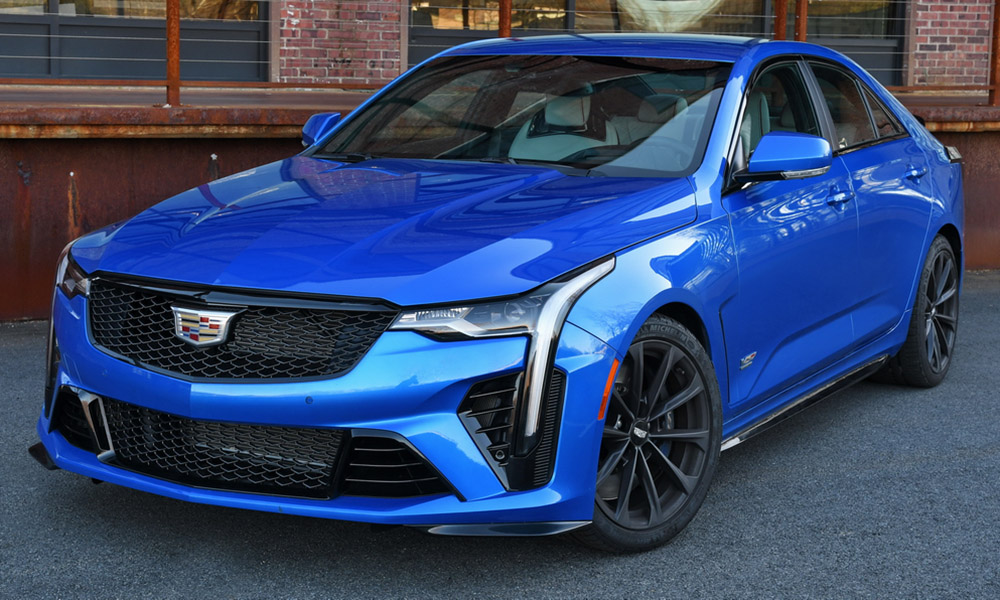
Photo: David Haueter
It’s been 20 years since the Cadillac CTS-V was first introduced. Back in 2004, the first CTS-V had a 5.7-liter V8 paired to a manual transmission with rear-wheel drive and was a revelation from a company that had traditionally been known more for sedate luxury cars.
Today’s CT4-V Blackwing and CT5-V Blackwing models are very similar in design and philosophy to the first CTS-V. Both cars have powerful engines mated to a rear-wheel drive chassis and come standard with manual transmissions.
The CT5-V Blackwing has a big 6.2-liter supercharged V8 under its hood that produces 668 horsepower and 659 lb.-ft. of torque, while the smaller CT4-V Blackwing goes with a 3.6-liter twin-turbo V6 that puts out 472 hp and 445 lb.-ft. of torque.
A look over the spec sheet of the CT4-V Blackwing that I drove reveals that the high-performance credentials of this car extend well beyond the engine.
Hardware upgrades include Brembo vented brakes front and rear, an electronic limited slip differential, a rear differential cooler and Magnetic Ride Control adjustable dampers. The six-speed manual is standard, but my test car came with the 10-speed automatic. The car comes fitted with Michelin Pilot Sport 4S tires on 18-inch wheels.
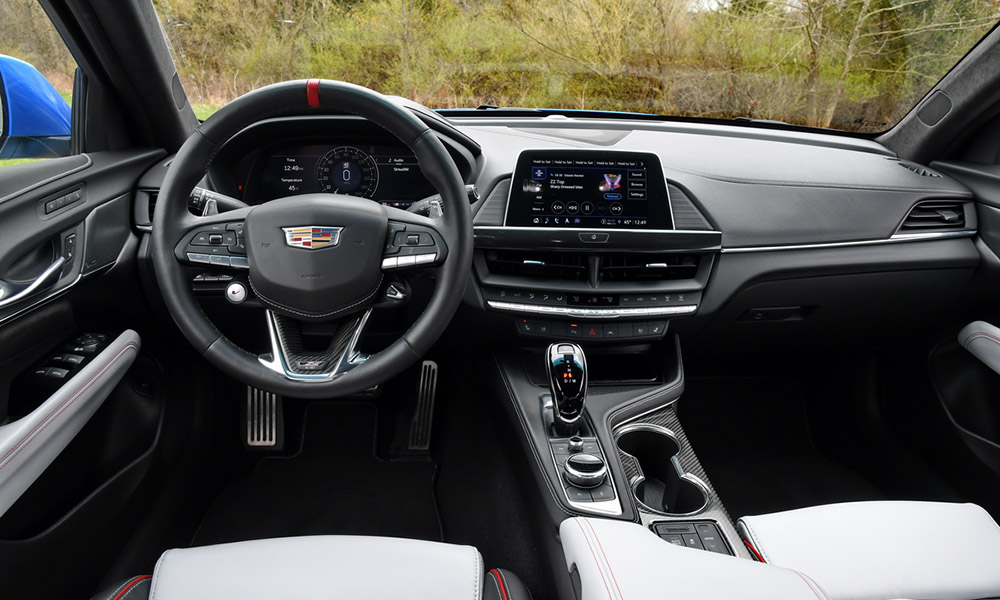
Photo: David Haueter
Inside, the cockpit of the CT4-V Blackwing also has features that differentiate it from the standard CT4-V model.
Carbon fiber trim on the center console and steering wheel hint at the car’s performance pedigree, along with more supportive seats. The car I tested also came with the optional performance data and video recorder ($1,600) that allows the driver to record video of track days with telemetry overlays and analysis.
Most high-performance cars these days give drivers the ability to tailor settings and the CT4-V Blackwing is no exception.
A mode switch near the cupholders allows drivers to choose between Snow/Ice, Tour, Sport, Track or My Mode, which allows the driver to change settings for Steering, Suspension, Brake Feel and Engine Sound.
Similar to the BMW M3, the Blackwing also allows the driver to choose among various traction settings, including Wet and Dry conditions, as well as Sport, Race 1 and Race 2, with the intervention getting more liberal as you move up from Wet to Race 2.
There’s also a “V” button on the left side of the steering wheel that allows for a one-button push to get to your favorite settings. The display also changes for the different driving modes.

Photo: David Haueter
From a design perspective, the CT4-V Blackwing is not all that much different in appearance from the standard CT4-V, though it does have a more aggressive front end and a trunk spoiler.
You can also dress it up with optional carbon fiber rockers or a front splitter (neither of which was on our test car). The Blackwing comes across as more of a blunt force instrument than a scalpel. It looks great from the front, but it looks bulky from the side and gets a little odd looking at the rear.
From behind the wheel, the CT4-V Blackwing is one of the best sports sedans you can drive today.
With 472 hp and 445 lb.-ft. of torque, this hefty 3,900-lb. car can go from 0-60 mph in 3.8 seconds with the automatic (3.9 with the manual), which matches the acceleration times of the BMW M3 Competition.
That being said, the Cadillac twin-turbo V6 is short on pizzazz and doesn’t really thrill the driver all that much. It’s powerful, yes, but it’s not the best part of this car.
The best part of this car is the feeling that you get when you drive it. In a time when the plethora of technology in cars has created more filters between the driver and the driving experience, the CT4-V Blackwing communicates exactly what it’s doing to the driver, with great feel through the steering wheel, the pedals, and the seat.
In this regard, the Blackwing is a level beyond the BMW M3, which is a benchmark in this class and lacks some of that visceral feel that the Cadillac has.
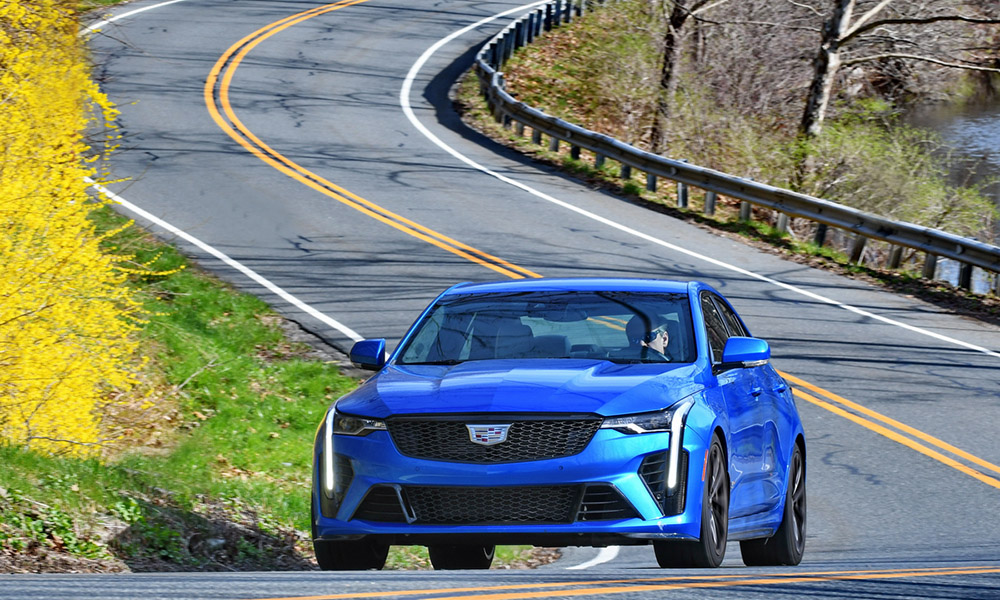
Photo: David Haueter
You don’t need to put this car into the more aggressive driving modes to get that level of communication. Most of my driving was with the steering, brakes and engine sound all in the middle setting and the suspension in the softest setting.
The suspension tuning with the Magnetic Ride Control dampers is very impressive and does a great job of smoothing out bumps but tightening up when the roads get curvy.
There’s a touch of understeer when you push it into corners harder, but overall, the car is very well-balanced. Putting the suspension in Sport mode makes the handling more responsive, but the suspension is so good I didn’t find myself changing it much. The track mode settings are strictly for track driving and are too firm for public roads.
The CT4-V Blackwing is also easy to live with as a daily driver. The seats are comfortable and supportive enough for long highway rides, the car is not overly loud and there’s plenty of room in the trunk.
The 10-speed automatic also shifts very smoothly and accurately and works well enough that you won’t find yourself using the paddle shifters for manual shifting very often. The controls and displays are also easy to live with once you figure out where everything is.
With a starting price of $61,495 USD, the CT4-V Blackwing is also a relative bargain compared to the $76,000 BMW M3 or the $80,200 BMW M3 Competition.
The biggest shame about both the CT4-V and CT5-V Blackwing models is that it is very unlikely that they will continue much further into the future as GM transitions more to all-electric vehicles, though how often they’ll be around is anyone’s guess depending on how those all-electric vehicles sell.
These models will likely go down in history as the best sports sedans that ever came out of GM.

Photo: David Haueter

















